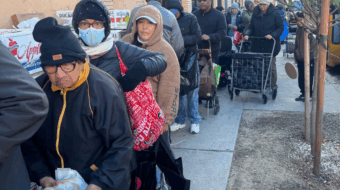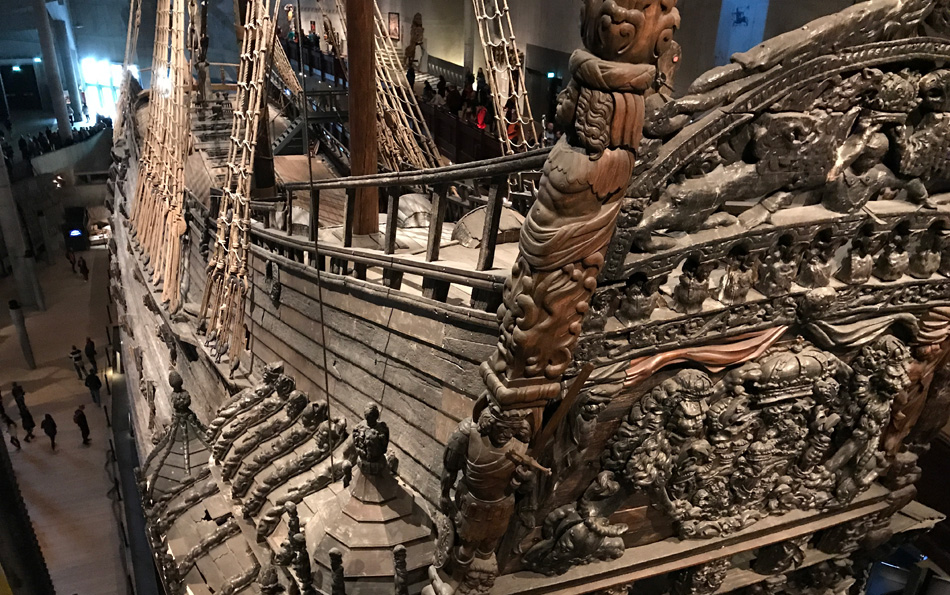
COPENHAGEN—My travelogue starts in Denville, New Jersey, where I visited some old friends for a night before boarding an SAS flight the next afternoon from Newark to Oslo. J.P. took me on a brief walking tour of the town center, a charming throwback to fifty or more years ago that attracts people looking for a quieter way of life.
I spotted the Viking Bakery and we went in, thinking it was possibly a Scandinavian place. The counter lady said no, it was a kosher bakery. Then a young man came out from the back and said, yes, it used to be Scandinavian. Do you still have any Scandinavian goods, I asked, thinking I’d prepare myself for what I might find abroad, and he replied, “Oh, yes, the Irish soda bread is Norwegian—or wait a minute, no, I think it’s Swedish.”
I got a few laughs retelling that anecdote, but my travels reflected a reality that I hadn’t expected. The standard idea about Scandinavia is how totally, homogeneously Aryan those countries are—I visited Norway, Sweden, and Denmark with my travel companion John. Once on the ground, we discovered that over the centuries, there has indeed been a lot of cultural and genetic exchange, at least among the ethnicities in the immediate vicinity of northern Europe. There is in fact a Norwegian soda bread which in a blindfold test might easily pass for Irish.
Linguists could have told you that: All the Scandinavian languages (not Finnish, however, as Finland is considered a Nordic but not a Scandinavian country) have old Germanic roots, as does Anglo-Saxon, the basic bone structure of English before William the Conqueror’s so-called Norman invasion (that is, from Normandy) in 1066. The French cobbled onto English all of our Latinate words, making English one of the most inconsistent, complex, diverse, and rich tongues of the world, not easy for foreigners to completely master, drawing its vast vocabulary from both Germanic and Latin sources.
Once you get the hang of it, you start recognizing the large body of cognates between the Scandinavian languages and English. Place names in rocky, mountainous Norway often end in the suffix -dal, which becomes “dale” in English, or valley, incorporated also into many English-language place names—anyone in Riverdale reading this? That name’s a mashup of Old French and Old Norse. It is said that when the Vikings came to what we know now as Ireland and the British Isles, they could converse intelligibly. So Irish soda bread may be Norwegian after all—or maybe Swedish!
Norway
We landed in Oslo after a night-owl flight and spent one day and night there to recuperate before taking a long-distance bus to the home of my L.A. friend now living in his small ancestral town of Kvinesdal—the valley of the Kvina River. Erling came with his family to the U.S. as a child and grew up in the Norwegian community of Brooklyn. There, he claimed, all the Norwegians knew each other—and all of each other’s business. This area in southwestern Norway, for a century beginning around 1850, sent many thousands of Norwegians to America. Erling was a member and officer of the Sons of Norway, an immigrant fraternal society, and has a wide circle of Norwegian-American friends, many of whom, like himself, have moved back here. It came as no great surprise when we started chatting with an American brother and sister on the bus who were heading to a town just short of Kvinesdal for a family vacation, and it turned out that Ann had been in Erling’s 1967 confirmation class in a Brooklyn Lutheran church. She showed me a picture of it on her phone with both of them in it. Well, Erling told me he knew everyone. From the bus, I called his number and said, “Hang on, here’s someone who wants to say hello,” and handed the phone over to Ann.
Erling was the perfect host for four days, driving us to places we would never have thought to see on our own—the coastal town of Flekkefjord, for example, whose central district still reflects the Dutch influence from 500 years ago. The Vikings were not the only great seafarers of the time—the Dutch, Germans, Danes, and Swedes got around quite a bit as well, leaving their architectural and commercial influence behind. We began to see how these lands were never really so homogeneous. Even here we found a grocery store well stocked with Middle Eastern products.
He took us to Fjotland, with its quaint church and village museum, and then to Knaben and its abandoned molybdenum mine which became a place of interest for the German occupiers during World War II. Kvinesdal has its own well-kept immigration museum in what was once a private home amusingly decked out with Americana of the 1950s and ’60s that immigrants shipped back to Norway. That night, at the local Sons of Norway group—most of whom had lived in Brooklyn at some point—a lecturer made a presentation about the Knaben mine. Back home in Kvinesdal they have a cozy retirement with ample Norwegian government support and their American Social Security checks.
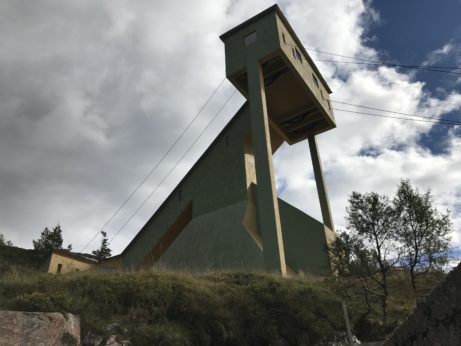
Saturday, September 2 was a red-letter day for the west coast port town of Stavanger, which reminded me of Provincetown and San Francisco. It was the city’s first-ever Gay Pride march and fair, with booths from all the political parties vying for the LGBTQ vote in the forthcoming elections. Conservative parties were well represented: The acceptance of LGBTQ people is so high in Scandinavia that conservatives would be foolish not to appeal to them. We marched through the streets with maybe a thousand others, with many more watching from the sidewalks.
The next day, Erling drove us to the Lyngdal county fair, which closely resembled our American counterparts—booths selling food products and kitchen gadgets, locally produced merchandise, some prize animals on display, a concert stage, carnival rides, an eatery with local specialties. A young fellow from Milan sold Italian cheeses. We drove on to Borhaug, another of these enchantingly civilized little coastal towns, this one on the Lista peninsula, where in my fantasies I could resettle for the last peaceful years of my life. Borhaug is especially noted for its lighthouse, and the WWII bunkers the Germans built to keep the Norwegian coast free from Allied incursion. On the surrounding rocky coastal plain, we were amazed to see a herd of free-roaming Andean alpacas, which apparently do well in this climate, raised for their fine wool.

Before leaving Kvinesdal, I took an early morning swim in the beautifully appointed Kvina Baden, just steps from Erling’s apartment. His people lived in this part of Norway, and are memorialized in town records. His parents’ grave sites are in Kvinesdal, and though we didn’t discuss it, I suppose that when his hour on Earth is up, he will be buried here too. In our fast-paced urban American society, we don’t often encounter people with such deep local roots.
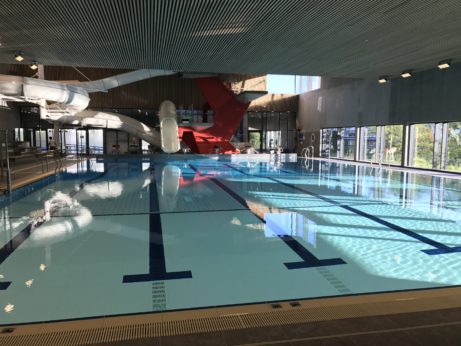
This trip originated with my desire to see the Norwegian fjords, and we did that with a day-tour out of the city of Ålesund, which itself is a beauty. In 1904, a fire burned down the central business district, and for some reason Germany’s Kaiser Wilhelm provided a passel of Art Nouveau architects—in Germany the movement was called Jugendstil—to rebuild the town. So almost every public building in a several-block radius reflects the gloriously playful, almost decadent pre-World War I esthetic whose inventiveness is so pleasing to the eye. There is likely nowhere else in the world with such a concentration of buildings in that style.
As a general reflection, Scandinavian cities are very walkable, or if distances are too far there are excellent public transport systems in place. Cities are well maintained, clean and modern, and no amenity is lacking for civilized life. People on the street seem to lead intentional lives—they walk with surety toward a known destination—and rarely did we encounter drunkenness, signs of addiction, or homelessness on the streets. In a few places, we saw people begging in somewhat bedraggled folk clothing—wide skirts, shawls—and it appeared they were Roma. Integration or cultural autonomy? This is one thorny problem that has not yet been successfully resolved. It saddened me to walk behind young people smoking, and polluting my clear Scandinavian air, but then I have that same complaint at home too, where the air is not so clear.
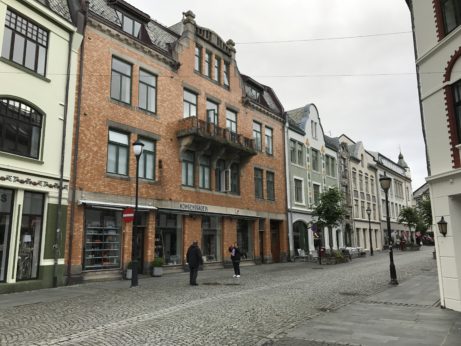
Hotels are clean, efficient, friendly, always with a huge, healthy breakfast spread that most days kept us going until dinnertime. The general consensus is that Scandinavia is expensive. Sometimes we felt a meal was overpriced by our standards, but by and large we found that food and accommodations were on a par with similar-range facilities at home. It’s just that at home we’re not staying in hotels every night and going out to dinner. Still, if your plate of food is a little high, you are not obliged to tip: Here, apparently, a waiter makes a living wage.
Next stop: Bergen, Norway’s second-largest city. The wharf, its raison d’être for centuries, was built by Germans of the Hanseatic League who established ports all around the North Atlantic and Baltic Sea for trade in fish, grain, pelts, whale oil, lumber, and other goods. This port is a UNESCO World Heritage site.
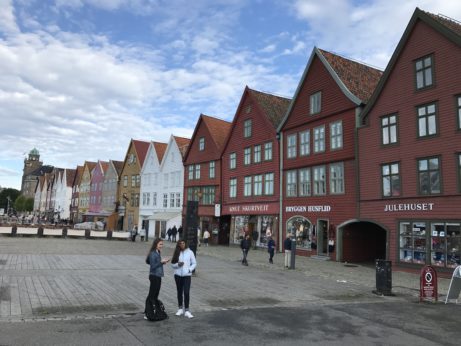
John and I are both music lovers, so we purchased tickets to the Bergen Philharmonic Orchestra conducted by the Englishmann Edward Garner, with renowned local pianist Leif Ove Andsnes as soloist. The new concert hall—Grieghallen, named for Norway’s most famous composer, Edvard Grieg—is stunning, and the program delighted us: An early, recently uncovered 1908 student piece by Igor Stravinsky, performed in its Norwegian premiere, and the rarely heard Rachmaninoff 4th Piano Concerto, which incorporates jazzy elements in a kind of “A Russian in New York” style. Tchaikovsky’s 4th Symphony completed the bill.
The next day we visited Troldhaugen, the Griegs’ residence a few miles outside of town on a lake, with a tour of the home and grounds and a mini-concert of Grieg piano pieces in the little auditorium there. That night, luckily for us, turned out to be Kultur-Natt (Culture Night), with concerts all over town in both expected and unusual places. We heard two affecting choirs, one in the principal church of Bergen, the other in a tiny old church in the compound that was once a leper colony.
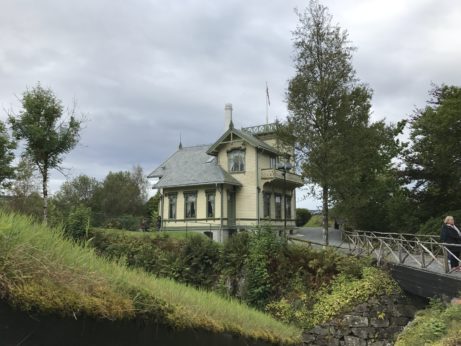
Our second fjord day started off with a train ride to Voss, a bus to Gudvangen, and a scenic cruise up to the inland resort town of Flåm. This fjord is also a UNESCO World Heritage site, and as we sailed up it, I felt thankful that such pristine, gorgeous scenery has been preserved, hopefully forever. If Norway derives a great percentage of its wealth from its oil industry to keep the welfare state thriving, that is nowhere near these green, sparsely inhabited waterways. There is some value to having a few people living in tiny isolated communities, but there are obvious challenges as well—getting the children to school every day, and securing medical aid when needed. But the collective Norwegian will seems to want to fulfill the basic needs of everyone, urban or rural, without distinction.
We returned to Oslo taking two trains, the first from Flåm to Myrdal on an old-fashioned railroad claimed to be the steepest elevation of any train in Europe. It stopped midway at a rushing waterfall where we were briefly entertained by a mystical singing Lorelei up on a hillcrest, according to the folk legend we had just heard about on the train’s speaker system. In Myrdal—ancestral home of the famous American sociologist Gunnar Myrdal—we boarded another train back to the capital.
Two more cultural events on our last rainy day in Oslo, and Norway: First, a visit to the handsome but smallish Edvard Munch Museum. His famous “Scream” painting is not here, but we did see a surprisingly varied output from this almost obsessively dedicated artist, Norway’s best known. The curators had selected a group of his portraits to display, and both their era and style reminded me of John Singer Sargent.
And then Puccini’s Tosca in an ultra-contemporary intermissionless production with hardly any sets at the futuristic Norwegian Opera and Ballet. It is, of course, a highly political opera that takes place as Napoleon’s armies are bringing the ideas of liberté, egalité, fraternité to the rest of Europe, and this staging ramped up the modern social significance. The revolutionary Angelotti (Yngve Søberg) comes on stage first with a sign saying “Your silence will not protect you.” Baron Scarpia (Claudio Sgura), the evil chief of the Rome police—as repulsive a character as Shakespeare’s Iago—goes around accompanied by two dwarves as a reminder of the time when the nobility kept them as pets. And he’s dressed unmistakably like Donald Trump—making him (and Melania) the second pair of operatic villains I’ve seen so attired in just the last couple of months! Rolls of sticky packing tape are unwound, binding the characters together in unwanted connection, as well as in intimate touch between Tosca (Svetlana Aksenova) and her lover, the painter Cavadarossi (Daniel Johansson). In director Calixto Bieito’s vision, the hostile crowd come out as Trump supporters, by inference turning the opera, which dates from 1900, almost into a proto-Mussolini prediction. Is this Oslo’s warning to the world?
Sweden
Classical radio stations frequently broadcast recordings with big-name conductors and the Gothenburg Symphony Orchestra, so John and I thought we shouldn’t pass up this second-largest city of Sweden (Göteborg in Swedish) before rushing to the capital, Stockholm. We passed several hours in the expansive Gothenburg Museum of Art, taking in their huge collection of Nordic painting, mostly 19th- and 20th-century work in the manner of contemporaries in Western Europe, but by far lesser known names. They featured a photo exhibition on Gaza, which a major American museum would not likely house. In the evening, the famous symphony played Stravinsky’s Rite of Spring with an all-male corps de ballet from the Göteborg opera that animated abstract patterns instead of following the original scenario—strange, and in the end a questionable match between music and performance, but lovely bodies in choreographer Roy Assaf’s hypnotizing motion. In the second half of the evening, Israeli choreographer Ohad Naharin offered a selection of short pieces, some with audience participation.
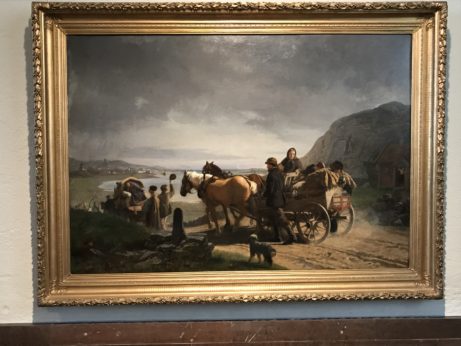
Our hotel in Göteborg was conveniently located right on top of the central railway station. In every room and in the public spaces, paintings, all obviously by the same artist, depicted smart, accomplished contemporary businesswomen. The artist used a palette of blacks, whites, and grays with highlighted spots of Chinese red for items of clothing, handbags, and lipstick. This was in all likelihood a mostly commercial hotel designed to make women clients and travelers feel comfortable and supported, although these images struck me as rather classist. They got me thinking about women we saw on city streets: Almost none, except maybe at the opera, wore high heels, and then it occurred to me why—so many streets are paved with cobblestones that walking in heels would truly be a challenge.
Stockholm is the largest city in Scandinavia. The local tourist board promotes it as “the capital of Scandinavia,” which of course it is not. The tourist rep we queried about that admitted that “the people in Copenhagen are not very happy about it.” Tourists in this large, historic, well-maintained city have a wide choice of activities to fill their time. A week could easily be spent here, but we had only three nights. We stayed at a modern new hotel catering to a youngish hip crowd. At that time, the Gather Conference was headquartered there, a sort of Ted Talk weekend combined with sessions on futuristic marketing. As a hotel guest, I was invited to join their 7 a.m. yoga class, which I did twice.
Our first order of business was to find a laundromat. We were directed to a square called Odenplan, named for the Norse god Odin, which we could reach by metro. The size of the city demanded that we purchase three-day passes for public transportation. With no difficulty, we found the laundromat, a small family business slated to close in the not too distant future because the owners had no one to pass the business on to, nor could they find a buyer. All homes and apartment houses have their own washers and dryers, so public facilities are not necessary, except of course for tourists. In fact, we learned, this laundromat was not only the only one in Stockholm, but in all of Sweden! With the right marketing plan, there is a goldmine of entrepreneurship awaiting the right investor!
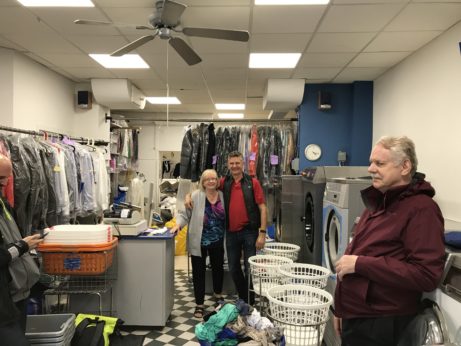
Our clothes clean, we returned to the hotel anticipating a busy next few days in the big city. For my bedtime reading, I tackled George Orwell’s novel Keep the Aspidistra Flying, a writer reading a fellow writer’s book—about a writer!
After a morning walking tour of Stockholm’s Old City (Gamla Stan), with lovely historic sights around each corner, we found ourselves at the royal castle in time for the changing of the guard. From an American perspective, it’s funny that these three continental Scandinavian countries (Iceland also counts itself as Scandinavian) are among the top tier of advanced social democracies in the world, and yet are monarchies.
The Scandinavian model, developed after World War II but with strong antecedents in the pre-war period owing to their large and influential socialist and labor movements, is almost certainly the highest expression of democracy that capitalism offers in the world today. In exchange for a high personal and corporate tax rate, citizens are guaranteed a generous opportunity for a successful life: excellent public education, the highest level of healthcare in the world, a fine public transportation system, labor rights and protection that we in the U.S. can only dream of, guaranteed pensions for a secure old age, among the greatest participation of women in governance and public life, an openness to refugee resettlement, and a well-maintained infrastructure and civic community that contribute to the overall wellbeing. People we spoke with identified housing as the country’s biggest problem.
The monarchies are quaint vestiges of their national history and identity, considered harmless and politically irrelevant, and perhaps a source of tourism and prurient curiosity about the lives of the “royals.” These countries have only tiny, insignificant republican movements.
Speaking of the monarchy, the highlight of our first full day in Stockholm was a visit to the Vasa Museum, a must-see experience for any visitor. The Vasa was a glorious towering warship decked out with more than 700 carved sculptures, the best and latest in shipbuilding technology, launched on August 10, 1628, when Sweden was truly a regional power, to show the Russians the superiority of Swedish naval prowess. It had a Dutch master builder who—and this was the Vasa’s only flaw—was obliged to accept the Swedish king Gustav Adolf’s design advice.
The Vasa set out from its dock into Stockholm harbor. A little breeze caused the ship to list slightly, but it righted itself. A second gust came, and this time the Vasa tilted over and within sight of the onlookers on shore, promptly sank. Out of the 200 men on board, most escaped with their lives, but 40 drowned. In the inquest following the tragedy, the Vasa was deemed to be top-heavy, with not enough room for ballast. Its fate was sealed in its very making, thanks to the king’s mandatory input. In the end, no one was held accountable because all paths led to the king’s own culpability.
For 333 years, the ship lay at the bottom of Stockholm harbor, gradually covered by layers and layers of silt, but not decaying much owing to the low salinity of the Baltic Sea. Starting in the 1950s, the technology existed to hoist the ship up and carefully dry it out so that it would not be subject to rot. Certain parts had gone missing, but most of the Vasa was intact, and it is now housed in a specially dedicated museum with informative didactic panels and videos and several levels of access, permitting visitors to view almost every angle of the vessel.
The Vasa is a supreme object lesson for the Swedish people, a monument to royal hubris, a chastisement against imperial overreach, a peaceful symbol for the nation (which remained neutral in both world wars), and a standing call to modesty and unpretentiousness, which are among the defining markers of the Swedish character. Glad to be done with its experiment in empire, it is hardly surprising that alongside its internal democratic institutions, Sweden is also one of the most generous supporters of anti-colonial movements and the underdeveloped nations, both in terms of public policy and charity.
On our last full day in Stockholm, we took a 2.5-hour boat ride out to Vaxholm, a resort island some distance away from the city, one of thousands in the harbor archipelago. These islands offer a measure of military protection for the capital, some economic benefit insofar as industries can be located on them, and breathing space for the residents of the national capital.
The faceless woman’s voice on the speaker system guiding us along the route talked about Sweden’s history as a nation of emigrants. For centuries it was among Europe’s poorest countries, so hundreds of thousands, perhaps millions, left to seek out freedom and opportunity abroad—the same reasons refugees and economic migrants come to Sweden today. We have already begun noticing that the immigrants to the Scandinavian countries—from Iraq, Syria, Somalia, Eritrea, and other places in Africa—don’t seem to be all clustered in the capital or even only in the largest cities. Even small communities, such as Norway’s Kvinesdal, have their immigrants. There’s widespread understanding of their need to establish safe new homes, although in each country, small parties and movements have embraced nationalist, anti-immigrant ideologies.
Sweden and Denmark, incidentally, are European Union members, not Norway; but all three have their own national currencies, not the euro.
That afternoon we took a one-hour train ride to the picture-book university town of Uppsala, which is also the site of the Gothic cathedral (the Dom kyrk) of the Lutheran Church of Sweden. This Dom is dedicated to my namesake, St. Erik! I never knew there was a Saint Erik; he’s the patron saint of Sweden, though buried elsewhere. I would have purchased a little statuette or some memento of him, but the gift shop had only a cheesy postcard (which I bought anyway).
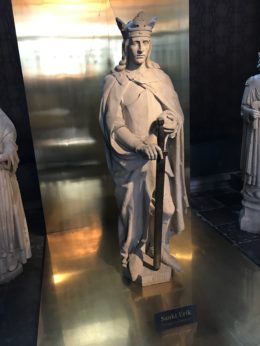
Right next door to the Dom stands the smaller Holy Trinity Church, from which we heard the strains of someone trying to pound out Sondheim’s “Send in the Clowns” on the piano. She turned out to be one of the pastors, rehearsing for their open house for students and the community, a place where people can come just for company on a Saturday night without any proselytizing. We were soon joined in conversation by another minister, a handsome young Black man who explained that his parents had emigrated to Sweden from Ethiopia.
Why did this smaller church stand right next to the Dom? we inquired, and we got an interesting answer. Centuries ago, the local farmers felt the people at the Dom were too haughty and disdainful of the poor, so they built their own church right next door where they’d feel more accepted. This “peasants’ church” was consecrated in 1343.
Religion in Scandinavia is a sign of the region’s advanced social system. The buildings themselves are maintained meticulously, as many of them are architectural treasures dating back to the Romanesque, then the Gothic, classical, Victorian, and later periods, and are irreplaceable parts of the national patrimony. But few people attend services regularly; mostly only for christenings, weddings, and funerals. Churches serve a wider social function today, providing meeting space for community groups, centrally located concert venues, and opportunities for volunteerism. As I have argued elsewhere, when people have their basic human needs met by the larger society and they are not fretting about hunger, employment, homelessness, debt, sickness, and death, there’s not too much else that requires prayer.
On the road
John and I were both flying out from Copenhagen, Denmark, so we had to figure out a way to get there from Stockholm. Instead of taking another train, we rented a car for three days, taking our time driving down the Swedish coast, seeing green, mossy, sparsely populated countryside and staying at smaller hotels in towns with some historical features. The Swedish coast on the Baltic Sea reminded us in many ways of the Norwegian coast on the North Sea, with precious towns based on fishing and farming, but all looking quite prim and well-kept. Roads are smooth and pothole-free, a joy to drive on. Obviously, Scandinavian taxes go to such infrastructural maintenance, not to militarism and empire building, a lesson they have thoroughly incorporated from their often gory history.
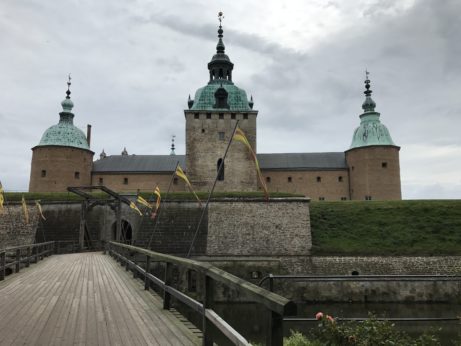
Our first overnight was at Kalmar, which features a big fortified castle that was once a sort of vacation home to successive monarchs while also serving as a military outpost, starting in the late 1100s, looking out over the Baltic Sea. Large, drafty rooms with not much furniture testified to a lifestyle of the rich and famous that was in many respects not so very comfortable. But they had a staff of 400 here, and loved to throw lavish parties for guests, ply them with wines and rare delicacies, and show off their tapestries, parquet floors, coffered ceilings, marquetry panels, and hidden passages. Our guide told us that over the centuries when this castle was in active use, there were 36 wars between the Danes and Swedes. It’s no wonder they got tired of their own history. At the Slottshotell (slott is Swedish for “castle”—think German Schloss) the evening dinner fare was Tex-Mex chicken over rice; globalization of taste has reached way out to slow-paced rural Sweden.
Kristianstad was our next layover, called “the most Danish town in Sweden” for its surviving architecture featuring certain vernacular elements introduced by the occupying Danes. We stayed in a Hotel First, one of a chain, located in an elegant former bank building. The next morning, we drove to Malmö, third-largest city in Sweden. We passed through velvety farmland, where for the first time we saw corn growing (a New World import), in what is considered the breadbasket of Sweden, the mildest, most temperate part of the country. This region is called Skåne, and it’s where most of the emigrants who headed for America came from. In fact, the word Scandinavia derives from this place.
Right across the water from Denmark, Malmö is full of impressive architecture, a handsome cathedral and old Nordic squares lined by imposing buildings dating from the 17th century to modern times. We checked in to another First Hotel there, and I soon discovered I had left my iPhone converter and charger in the electric socket in our room in Kristianstad. I reported my problem to Daniela, the front desk clerk, about 4 pm and shortly got word that it had indeed been found by the cleaning crew. Could it be messengered to me, or could I leave them my hotel address in Copenhagen?
Let’s try mailing it here, there’s still time for them to get it to the post office, Daniela said. I felt dubious about this plan, knowing what I know about our own postal service. But sure enough, about 10:15 the following morning, right before we were to check out and proceed on over the bridge to Copenhagen, it arrived in perfect order. What a system!
Copenhagen
Of Denmark we only saw the capital city, another world-famous tourist destination deserving of more time. We had a tour of Queen Margrethe’s castle, Christiansborg Slot, which curiously, in a separate wing, houses the politically independent Danish Parliament. We took the basic tour with our guide Peter, who also serves as part of the royal retinue when the Queen hosts receptions. We didn’t add on the “Behind Colonial Mirrors” exhibition in the castle about the life and times of the Danish West Indies, which ended a century ago, in 1917, when Denmark sold those islands to the U.S. But some of the hardwood mahogany furniture included in that exhibition was scattered around some of the rooms we passed through—another example of how conscious the Danes are of their previous colonial escapades, and how happy they are to be free of them now.
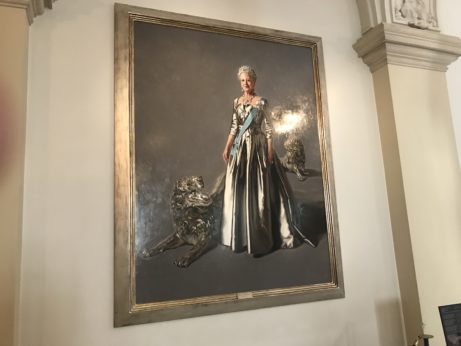
The National Museum of Art is a splendid place. There was an exhibition there too about the Danish West Indies, featuring paintings and sculptures showing white and Black faces and relationships in the former colony. We paused briefly to listen in as a school teacher sat her teenaged students down on the gallery floor for a discussion about the Danish colonial past, race, slavery, exploitation, and how art represents these aspects of society. She was speaking Danish, of course, but in context we got the drift.
Another exhibition there told a different, but in a larger sense a related story. “Crossing Borders, Europe 1300-1800” showed how artists such as Caravaggio moved back and forth between Italy and the Netherlands, carrying their techniques with them and also learning from their hosts. Though some artists stayed close to home (Rembrandt, for example), many other artists set out on a “Grand Tour” which took them to exotic places such as Venice and Rome, or even the Holy Land, North Africa, or America. The show brought out other “border crossings” as well, for example the “border” between Catholicism and the Protestant Reformation. How did artists deal with a society around them that was transforming as they were trying to get commissions and adequately depict their times? One thing I noticed is that in paintings depicting episodes in the life of Jesus, all the women are wearing what we would today call a hijab, a head covering, and who thinks twice about that? Yet in modern society in the West, the meaning of the hijab has itself “crossed borders” as a signifier of the “other.”
I’ve already written separately about the wonderful Workers Museum in Copenhagen, which I visited on my last day after John had left to continue his journey. On that day, I also saw the “Little Mermaid” sculpture in the harbor area, and late that afternoon went to the Trinitatis Chuch for a concert by the Nairobi Chamber Choir, which was just finishing up a two-week residency in Denmark. They received a thunderous welcome, and deservedly so. After the concert, I went for a Greek dinner.
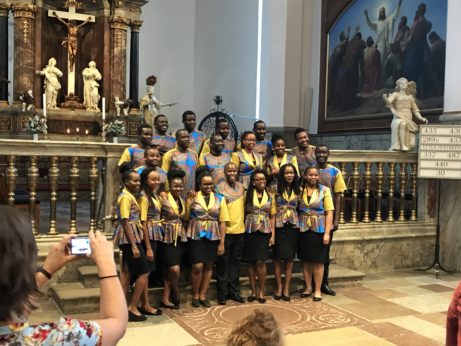
It’s a myth that nations are so homogenous and self-contained, especially in the modern world—though if you read ancient texts such as the Bible you see it was not much different then either. Thirty-six times in the Hebrew Bible the reader is enjoined to “welcome the stranger for you were a slave in Egypt.” On the surface, the Scandinavian countries may appear fairly pale, but throughout their history there have been both invasions of their own lands by other peoples and nations, and they themselves have gone out making colonies and building empires.
And that’s why Irish soda bread can indeed be Norwegian—or maybe Swedish.



